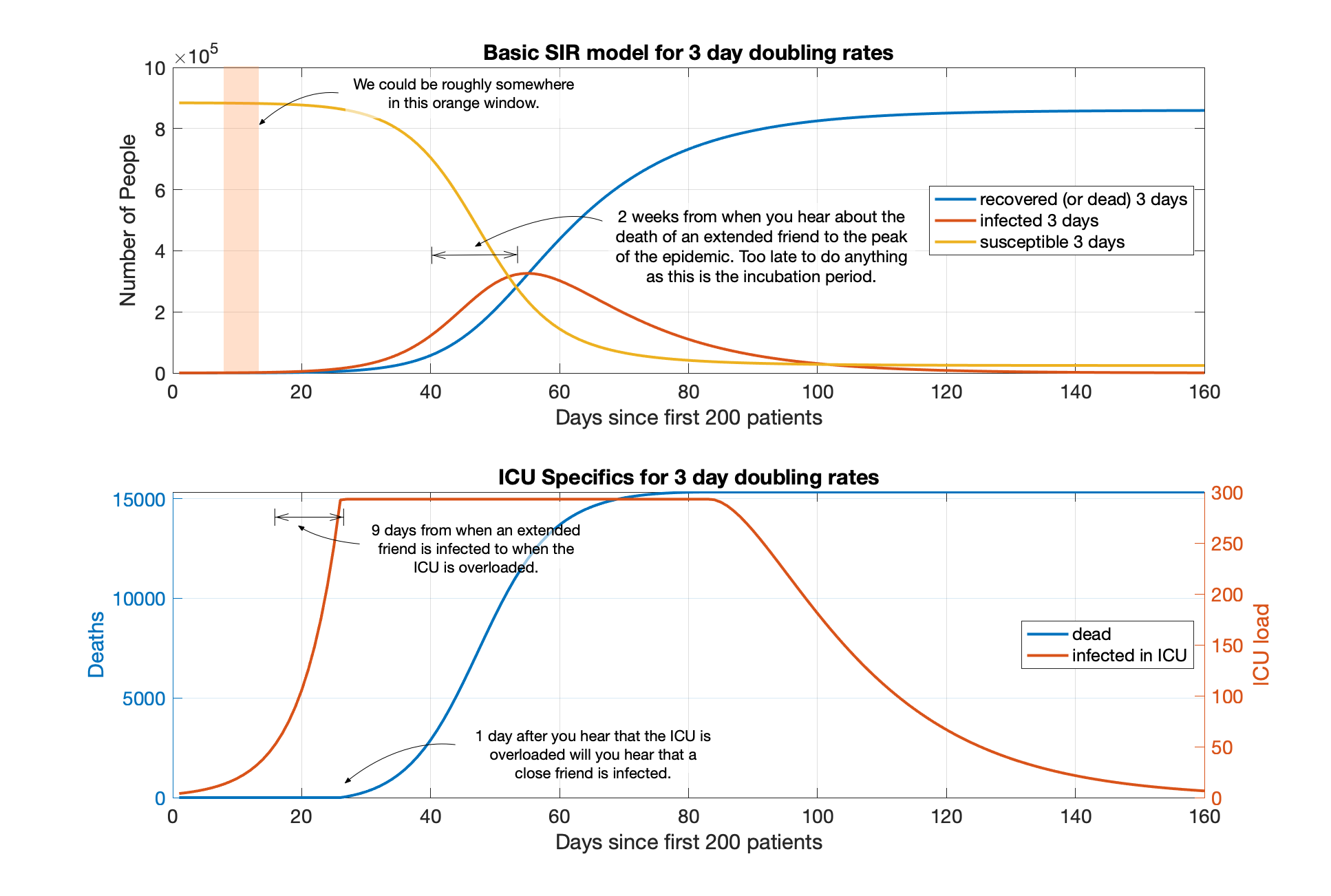You and your local community vs the pandemic.
A ventilator in California cannot help a doctor in New York. An open hospital bed in LA is not of use to a patient in San Francisco. The COVID-19 growth rates seem to be quite different in different communities for reasons not related to social distancing.
It is in the nature of a virus’ exponential growth that by the time the crisis has touched you personally its growth will be so overwhelming that you will not be able to alter its course.
Take away: Your growth rate may be lower than other places but do not become complacent. If the virus is still growing, there will be a crisis in your community. Understand what the course of the epidemic is likely to be in your community. Act forcefully now because by the time you’ve been personally affected by the virus it will be too late.
The Personal
A friend mentioned to me that it was odd sheltering in place even though he didn’t know anyone affected by the virus. I thought about this a bit, developed the following toy simulation in which I realized that by the time you know of an acquaintance affected by the virus there is a very short time until you know a close friend affected by the virus until the point your family is affected. This is the nature of exponential growth.
I just learned that a 45 year old friend of a friend in New York died of COVID-19.
Your Community
I came to this insight when I first plotted COVID-19 caseloads over time for San Francisco, California, and for the United States. I noticed that the growth rates were very different for San Francisco and the United States. I was initially pleased that San Francisco’s growth rate was slower than the United State’s growth rate, but then it struck me that our growth rate was still growing without change.
It is individual Emergency rooms that will be overwhelmed not the entire state of California all at once.
Your own community’s growth rate is crucial for you to know and keep track of so that you know when the crisis will hit your community and so that you can know whether the governmental and personal measures being taken in your community are having an effect.
I am currently worried that despite the shelter in place order within San Francisco I still see an exponential growth of cases. I would like to have more information so that I could estimate when hospital’s are likely to be overwhelmed in San Francisco. (See the need for more high quality data.)
Look at your community’s growth rate.
The New York Times just dumped a mass of county level data on coronavirus cases. Adrian took up the mantle and produced the following widget which we will update as much as we can.
Personal effects of COVID-19 as seen in a simple SIR model.
I changed a very simple SIR (Susceptible Infected Recovered) model of this epidemic to include deaths due to ICU overload in a very simple fashion. I then used the results of the simulation and some additional math to ask myself if I were in this scenario and I had.
40 close friends in my city and
250 extended friends in my city
How would I personally see the progression of this epidemic in my community. This is portrayed in the last of the three graphs. The red lines are the chance that you know someone who’s infected. The blue lines are the chance that you know someone who’s died. The dashed lines are people in your extended network of friends. The solid lines are close friends. Once the lines cross 50% you are more likely than not to know someone in that category. I annotated the chart above to call out the fact that you really don’t have much warning.
I changed a very simple SIR (Susceptible Infected Recovered) model of this epidemic to include the following assumptions.
The only time people die in this simulation is when there aren’t enough ICU beds to go around. In that case I declare that anyone without an ICU bed dies.
Ninety eight percent of the people who are infected need no additional care and recover on their own.
The remaining 2% of infections need ICU care but eventually all those patients, if they have an ICU bed, recover on their own too.
I assume roughly 300 ICU beds for a population of 884,000. These are based roughly on San Francisco.
The doubling time in this model is without social distancing. If you’d like to see results with social distancing let me know.

